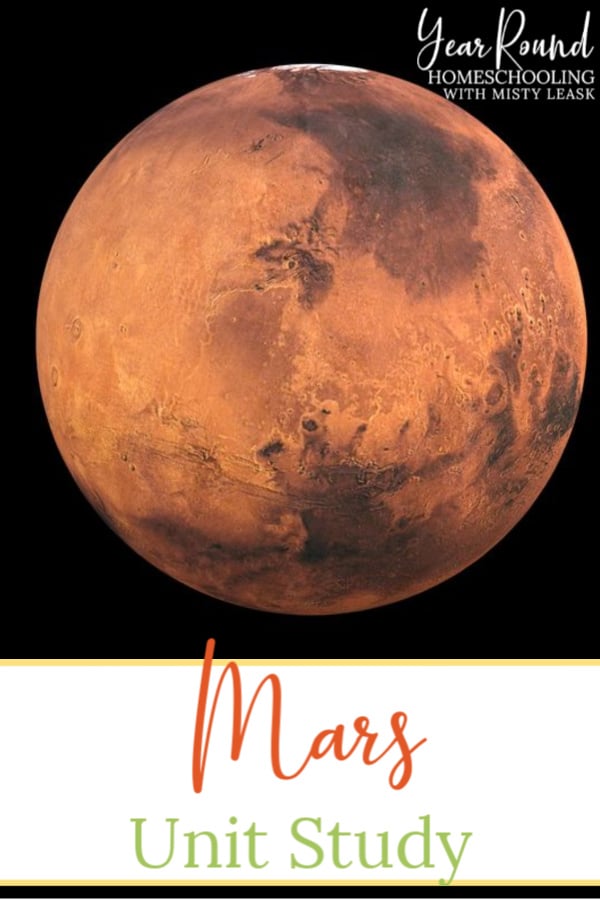Have you or your kids ever thought about visiting Mars? While it isn’t possible yet, you can learn all about ‘The Red Planet’ through this fun Mars Unit Study!

Traveling to Mars is something that many have dreamed of doing — including my husband and stepson. It was one of their most talked-about things when I first met them.
Personally, I don’t love to fly, so I am happy looking at the videos and pictures on my computer. I am in awe of the universe that God created and even more so the more I learn about it.
Mars Unit Study
Mars
One of the most explored plants in our solar system is Mars. Over the years, there have been several spacecraft, rovers and landers exploring the atmosphere and planet itself.
The color of Mars is due to the presence of rusty iron on the surface of the planet.
It isn’t surprising that Mars and Earth have many similarities being next-door neighbors in the solar system.
Olympus Mons, the largest mountain in the solar system is found on Mars. It is three times larger than Mt. Everest on Earth.
There is also a range of canyons on Mars that stretch over 2 miles long and is nearly 4 miles deep! For comparison, the Grand Canyon on Earth is only 1 mile deep!
- Name
“The Red Planet” was named after the Roman god of war because of the resemblance of blood in the planet’s color.
- Size
Mars is the 3rd largest terrestrial planet and the 7th largest planet in the solar system.
-
- Radius
The radius of Mars is 2,106.1 miles. You can easily figure out the radius of any planet using the distance from the center to the edge of the planet.
-
- Diameter
Once you know the radius of a planet you can find its diameter easily. Simply take the radius and multiply it times two. In doing so, you’ll find that Mars’ diameter is 4,212.2 miles.
-
- Mass
At 642,000,000 trillion metric tons, Mars is the 2nd smallest planet when measured by mass. Mass is measured by how much matter an object has within it. Be sure not to confuse mass with weight.
-
- Volume
The volume of Mars is 39,133,515,914 cubic miles. Finding the volume of Mars is a bit more complicated than figuring its diameter or mass. To find Mars’ volume you’ll need this mathematical formula, V = 4/3 pi x r^3, and the radius of the planet.
-
- Surface area
Mars has a surface area of 55,742,106 square miles. To find the surface area requires you to determine what number of square units will exactly cover the surface of a sphere. You’ll need this formula to determine Mars’ surface area, (or any sphere) on your own.
-
- Density
The density of Mars is 3.93 g/cm³ making it less dense than Earth. This would indicate that Mars’ core contains lighter elements.
- Moons
Mars has two small moons, Phobos and Deimos, both of which were named after the horses that pulled the Greek god, Ares’ chariot.
- Location in the Solar System
Mars is the 4th planet from the Sun and the outermost terrestrial planet in the solar system.
- Distance from the Sun
All planets are always moving, but on average Mars is 133,878,103 miles from the Sun.
- Light time from the Sun
It takes 12.6 minutes for light from the Sun to reach the planet Mars. Since Mars’ is the neighboring planet to Earth, we would see the sunrise before someone on Mars would.
- Layers
The planet Mars has three layers. Its core is dense and made of iron, nickel and sulfur. Just outside the Mars’ core is a rocky mantle that can be up to 1,170 miles thick! The top layer of Mars is its crust. The crust contains iron, magnesium, aluminum, calcium and potassium and ranges from 6 to 30 miles in depth.
- Temperature
The average temperature on Mars is -81 degrees Fahrenheit. However, they can be as high as 70 degrees Fahrenheit or as low as about -225 degrees Fahrenheit.
- Speed
Mars travels at a speed of 14.5 miles per second! In one hour Mars travels 52,200 miles in one hour and 1,252,800 miles in a day!
- Orbit
It takes nearly 2 years on Earth for Mars to orbit the Sun! Mars completes an orbit around the Sun in 687 Earth days.
- Axis Rotation
The complete rotation of Mars on its axis takes 24.6 hours.
- Atmosphere
Mars’ thin atmosphere contains mostly carbon dioxide, nitrogen and argon gases. Due to the thinness of the atmosphere on Mars, heat from the sun escapes the planet rapidly. The sparseness of Mars’ atmosphere does not protect it well from impacts from various objects in space.
Please note, that some of the resources below may include evolutionary information. I encourage you to have a conversation with your children or preview these resources prior to assigning them as part of your homeschool studies.
Articles
Literature
 Mars' First Friends: An Edu...Shop on Amazon
Mars' First Friends: An Edu...Shop on Amazon The Rocket that Flew to Mar...Shop on Amazon
The Rocket that Flew to Mar...Shop on Amazon MARS - The Red Planet! Spac...Shop on Amazon
MARS - The Red Planet! Spac...Shop on Amazon Mars: Explore the mysteries...Shop on Amazon
Mars: Explore the mysteries...Shop on Amazon I Am Mars: A Book About Mar...Shop on Amazon
I Am Mars: A Book About Mar...Shop on Amazon You Are the First Kid on Ma...Shop on Amazon
You Are the First Kid on Ma...Shop on Amazon NASA Mars Mission for Kids:...Shop on Amazon
NASA Mars Mission for Kids:...Shop on Amazon Curiosity: The Story of a M...Shop on Amazon
Curiosity: The Story of a M...Shop on Amazon National Geographic Readers...Shop on Amazon
National Geographic Readers...Shop on Amazon Mars: The Red Planet: Rocks...Shop on Amazon
Mars: The Red Planet: Rocks...Shop on Amazon Welcome to Mars: Making a H...Shop on Amazon
Welcome to Mars: Making a H...Shop on Amazon Can We Live on Mars? Astron...Shop on Amazon
Can We Live on Mars? Astron...Shop on Amazon Mars for Kids (Tinker Toddl...Shop on Amazon
Mars for Kids (Tinker Toddl...Shop on Amazon Destination: Mars: Revised ...Shop on Amazon
Destination: Mars: Revised ...Shop on Amazon Max Goes to Mars: A Science...Shop on Amazon
Max Goes to Mars: A Science...Shop on Amazon Mars Rover Rescue (Epic Spa...Shop on Amazon
Mars Rover Rescue (Epic Spa...Shop on Amazon The Mighty Mars Rovers: The...Shop on Amazon
The Mighty Mars Rovers: The...Shop on Amazon Mission: MarsShop on Amazon
Mission: MarsShop on Amazon Mars Up Close: Inside the C...Shop on Amazon
Mars Up Close: Inside the C...Shop on Amazon Hey-Ho, to Mars We'll Go!: ...Shop on Amazon
Hey-Ho, to Mars We'll Go!: ...Shop on Amazon Mars Spaceship (All About M...Shop on Amazon
Mars Spaceship (All About M...Shop on Amazon Goodnight Mars: A Sci-Fi ST...Shop on Amazon
Goodnight Mars: A Sci-Fi ST...Shop on Amazon Missions to Mars (Kid's Lib...Shop on Amazon
Missions to Mars (Kid's Lib...Shop on Amazon Red Rover: Curiosity on Mar...Shop on Amazon
Red Rover: Curiosity on Mar...Shop on Amazon
Videos
Art
Crafts
Create 3D Glasses (for these 3D Mars Images — then create your own!)
Mars Pathfinder Spacecraft Model
Balloon Powered Lander
Games and Activities
Aerodynamics of Mars Global Surveyor
Printables
Maven and Curiosity Coloring Page
What did your kids enjoy learning the most through your Mars unit study?

